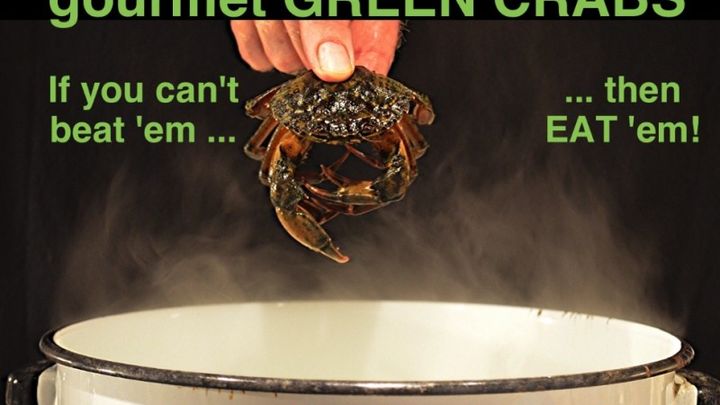
Green Crabs: Eat The Enemy!
Donation protected
Help a team of scientists and activists turn an invasive coastal species into delicious gourmet food! Green crabs (Carcinus maenas), originally from Europe, are swarming in U.S. waters thanks to hotter temperatures, overfishing, and habitat destruction. These small, voracious predators wipe out valuable clam and mussel beds and destroy eel grass (an essential nursery for young fish). They’re ecological marauders. Bad news!
Luckily, there’s a terrific way to help control green crabs: Eat them! They have an extraordinarily rich, long-lasting umami flavor. A stock or broth made from green crabs enhances the other tastes in a dish, making them linger on your palate, like notes that hang in the air in a cathedral after the music stops. Though the shells are normally too hard and small to be eaten whole, there are at least three ways to bring them to the culinary market. We’ve already made progress on all fronts and are seeking bridge funding to last us through spring 2017.
Our projects are: 1) Introducing mazanetta, a green crab caviar-crabmeat blend traditionally made in Venice Italy, to the U.S. market. Mazanetta will be featured in a free gala event on December 8, 2016 at the Boston Public Market (sponsored by Red's Best seafood company). 2) Expanding the supply of live green crabs for restaurant chefs, for making gourmet stock or broth. Marekting through word of mouth, Facebook and other electronic media, and other channels, weekly shipments in New England and New York have surpassed our original goal of 1,000 lbs per week and shipments are trending rapidly higher. 3) And finally, developing a new product, soft-shell green crabs. When crabs molt or periodically shed their shells, they can be cooked and eaten whole, and they are a gourmet treat. Working with Italian and Canadian colleagues, our team members from mid-coast Maine figured out the pre-molting signs, a major breakthrough. Now we want to see if we can get funding to refine our production techniques in 2017, the next step in creating a new industry.
We are a small collaborative network of scientists and activists from coastal Massachusetts and Maine. For more about us, our projects and other ways to contribute, visit our website. Through this website we will share our findings with other researchers around the world. The big picture is, green crabs are just one tiny symptom of the rapidly changing oceans. We can't completely restore the old coastal ecology, but we can adapt to change and try to encourage free market incentives – for trappers and seafood wholesalers and chefs – to drive positive change. We think the approach we are using makes sense and can be a model for other efforts to create a healthier environment. Please give as generously as you can, and if you live near Boston, please contact us. We’ll try to figure out a way for you to try green crabs in your own cooking.
Luckily, there’s a terrific way to help control green crabs: Eat them! They have an extraordinarily rich, long-lasting umami flavor. A stock or broth made from green crabs enhances the other tastes in a dish, making them linger on your palate, like notes that hang in the air in a cathedral after the music stops. Though the shells are normally too hard and small to be eaten whole, there are at least three ways to bring them to the culinary market. We’ve already made progress on all fronts and are seeking bridge funding to last us through spring 2017.
Our projects are: 1) Introducing mazanetta, a green crab caviar-crabmeat blend traditionally made in Venice Italy, to the U.S. market. Mazanetta will be featured in a free gala event on December 8, 2016 at the Boston Public Market (sponsored by Red's Best seafood company). 2) Expanding the supply of live green crabs for restaurant chefs, for making gourmet stock or broth. Marekting through word of mouth, Facebook and other electronic media, and other channels, weekly shipments in New England and New York have surpassed our original goal of 1,000 lbs per week and shipments are trending rapidly higher. 3) And finally, developing a new product, soft-shell green crabs. When crabs molt or periodically shed their shells, they can be cooked and eaten whole, and they are a gourmet treat. Working with Italian and Canadian colleagues, our team members from mid-coast Maine figured out the pre-molting signs, a major breakthrough. Now we want to see if we can get funding to refine our production techniques in 2017, the next step in creating a new industry.
We are a small collaborative network of scientists and activists from coastal Massachusetts and Maine. For more about us, our projects and other ways to contribute, visit our website. Through this website we will share our findings with other researchers around the world. The big picture is, green crabs are just one tiny symptom of the rapidly changing oceans. We can't completely restore the old coastal ecology, but we can adapt to change and try to encourage free market incentives – for trappers and seafood wholesalers and chefs – to drive positive change. We think the approach we are using makes sense and can be a model for other efforts to create a healthier environment. Please give as generously as you can, and if you live near Boston, please contact us. We’ll try to figure out a way for you to try green crabs in your own cooking.
Organizer
Roger Warner
Organizer
Ipswich, MA